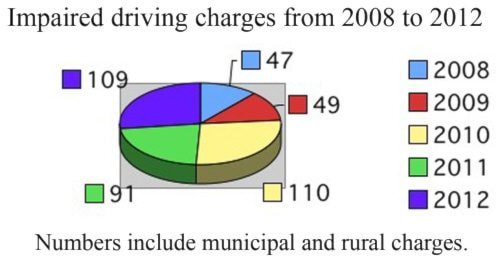“Welcome to the Impaired Driving Capital of Canada.”
RCMP Staff Sgt. Cameron Chisholm opened his presentation at the Jan. 15 Coffee with Council meeting with that provocative statement.
“It’s very sad when you have to say that but that’s the reality we have in front of us.”
Chisholm was one of two presenters at the Kinsmen Community Centre with Mayor Larry Henkelman and town councillors in attendance. Follow up questions were permitted in relation to the information presented. Chisholm’s focus was on impaired driving statistics in Ponoka, comparing municipalities along the Highway 2 corridor.
He presented a five-year snapshot of impaired driving charges:
• 2008 had 37 municipal, 47 total with rural charges.
• 2009 40, 49 total.
• 2010 91, 110 total.
• 2011 66, 91 total.
• 2012 80, 109 total.
“That’s very serious in this community,” Chisholm said grimly.
Comparing per population ratios in 2012 for communities along Highway 2, Chisholm said Ponoka had one impaired driver for every 84 residents. Wetaskiwin in comparison showed one for every 215.
Chisholm used an Edmonton Journal article reporting Kelowna, B.C. as being the drunk driving capital of Canada with 583 incidents per 100,000 but he feels Ponoka is higher in comparison.
“They were named the Impaired Driving Capital of Canada. Well folks, we have 1,181 (per 100,000 people). We are now the Impaired Driving Capital of Canada if you want to use the stats and the math,” he stated.
Kelowna’s population is more than 117,000 while Ponoka has 6,773. Chisholm is multiplying the population with the impaired charges as a way of comparison.
“In 2009, 41 per cent (16 people) of the drivers we caught (in town) were from Ponoka. In 2012 that goes down to 24 per cent (19 people),” explained Chisholm.
He also pointed out that 28 per cent of those charged in 2009 (11 people) were from within a 40-kilometre radius outside of Ponoka and in 2012 the amount rose to 54 per cent (43 people). He chose not to reveal where those people reside but he feels it shows a large shift in people coming to Ponoka since Wetaskiwin’s bylaw passed.
More stories on this issue in this week’s paper and on the website:
● Comparing Ponoka to Wetaskiwin after 2010
● Impaired driving investigations take time
● Over-serving and the AGLC
● Mixed reviews from stakeholders at Coffee with Council
● The three faces of alcohol and its costs explained
